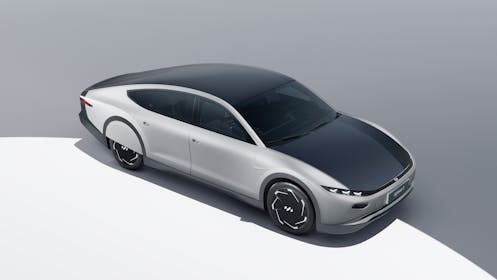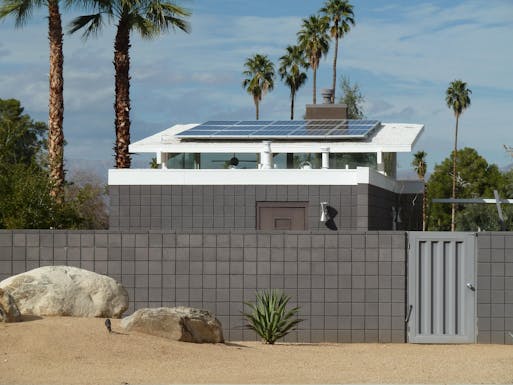Media | Articles
Piston Slap: Can you solar charge an electric car? Should you?

Eddie writes:
I read your article and comments on solar charging for parasitic draw and was wondering if that same technique would help with an EV. I don’t know about anyone else but my vehicle normally sat at work for 8-10 hours Mon.-Fri. Could that time be used for a little solar charging? Thanks for the good reading!
Sajeev answers:
Wow, what a question! It certainly brings a nostalgic twinge to my soul, as I was once a mechanical engineering student with a tangential connection to my college’s solar vehicle team. I would have dug deeper into that world, was it not for the personality conflicts. Then again, what I experienced in the college of engineering is fantastic training for how engineers have to work in the real world of automobiles. Welcome to the jungle…but I digress.

Back to your question: there is no easy solar charging solution like the ones we saw in our last installment to keep a 12-volt car battery topped up. While you could, you likely shouldn’t for these reasons. Sad, but true as the technology isn’t there (yet?).
Marketplace
Buy and sell classics with confidence
Even the folks at Lightyear say their solar powered car can only add a maximum of “70 kilometers of range per day from the sun alone.” That’s the maximum charge possible, on a vehicle designed to prioritize efficiency. I have concerns that Lightyear’s aerodynamic wonder might not meet the safety and performance requirements we expect here in North America. You’d need a significant solar charging infrastructure to power a big-ol’ North American EV, so it’d be a false economy to not build it for your entire household instead.
But there’s still an easy answer, just not an affordable one like that 12-volt car battery: consult with a solar panel/battery backup installer in your area and get ready to fork over significant amounts of cash.
I will readily admit that my knowledge on this subject is lacking, but this study suggests you need “around 4,000 kWh of electricity per year to operate” your EV. You need to know the wattage produced by solar panels (that are readily available on the market) and the battery size (in KWh) of your car. From there, you can calculate the number of panels needed to keep the car charged. But that assumes perfect lighting conditions, and that your home won’t suck some of the juice away during the day.
Perhaps another route is to first consider these questions:
- Do you have enough space for all these panels?
- Will the panels get enough sunlight throughout the day to actually get the job done? What about in the wintertime?
- How many panels can you afford?
- Will you store extra juice with an in-home battery when you’re driving? (That could be a game changer for your needs.)
- Can you afford it, assuming you receive tax credits?
- Should you buy a Ford Lightning instead of an in-home battery? (Just kidding…maybe?)
Necessary aside: I fully expect to hear statements to the contrary, especially considering the cost and environmental benefits of the batteries used in this equation. Fair points to be sure, but if you’ve already spent the cash for an EV, going all in with solar charging at home diminishes the problematic elements. He’s already knee-deep in it, might as well dive all the way in!
I personally love the idea of home solar charging with a battery: I am hooked on the “thirsty” acceleration of cars like the Lucid Air, and the dynamics of the Porsche Taycan, and I was without power for days when Texas’ power grid collapsed. Solar would make life easier and reduce some “economy guilt” from jackrabbit starts using the 800+ horsepower available from top-dollar EVs. In theory at least, as I have yet to make the change to EV propulsion and I learned to cope without power and water for days.
But that’s just me. What say you, Hagerty Community?
Have a question you’d like answered on Piston Slap? Send your queries to pistonslap@hagerty.com, give us as much detail as possible so we can help! Keep in mind this is a weekly column, so if you need an expedited answer, please tell me in your email.






Yes? Yes! I have solar panels at home which power my home and charge my BMW i3. I try to charge the car during daylight hours so that the charge is direct. The way it works is that the excess power from the solar panels goes back onto the grid. The power meter goes backwards. I get this power back on cloudy days or when the panels are covered with snow. This is been working great for 6 years now.
Fantastic to hear! I was hoping someone with experience would chime in, as this technology has been readily available for years. Thank you!
Fun article, got me thinking tangentially:
Legislative will may eventually make these things affordable. Science will surely improve the carbon math.
Ironically, I’m not sure we really step back from some of these “issues” and think about it.
-Volvo’s own study (last year?) said their new EV vs. their new ICE it took 7 years for the EV to be zero carbon. With an asterisk that the EV had a 10 year life span (US fleet trending towards 12 year average –that math matters elsewhere/big picture).
But my old Hagerty insured vehicle already exists. It has no “being born new” pollution to carbon count. So does it take 40 years of daily driving that Volvo EV to get to pollution (I mean carbon neutral) math? [But in the meantime I have bought 4 new EV to get there…]
And I live up north, so I only drive that vehicle seasonally… so 80 years… but not daily more like once a weekend so a couple of centuries to get to carbon neutral? If carbon math was the end-all I could justify a fleet of existing vehicles (could I afford the insurance/registration/etc.)
^the point being all the talk is about new things replacing new things. Reducing use and Reusing as much of what is already built should be a bigger part of the math discussion. Recycling when you can’t do either of those and new things only when you must…
Interesting points, but older vehicles are not exactly as reliable as newer ones (especially with all the tech that comes in cars from the last 15 years) and our society still outright encourages people to sell their old car and buy a new one. You could say that journalists like myself are part of the latter, and you’d probably be right.
In a perfect world we’d all use less by taking the bus and riding bikes. Traffic where I live is getting bad enough for me to consider it, except those without cars are treated like second class citizens here.
Sorry for that digression, but when you consider everything about a car, including the durability/workability of modern turbocharged, direct injected, CVT’d, etc. vehicles, I totally understand why people want to ditch them for something “better” for their needs.
No need to apologize for a digression when my whole post was the same!
I think we (in North America as a generalization) are obsessed with new and pristine. That’s comes with an environmental cost, whether the newest things are “better” or not.
Trading tailpipe emissions away presently has a great environmental cost somewhere else.
Toyota’s the only one saying “hybrid already meets the goals for most situations, why EV?”
Nobody with power is saying “let’s rebate propane conversions with 40+ year old tech that saves 33% emissions per existing vehicle immediately”.
So I remain unconvinced that saving the environment is actually the main goal of some of the loudest EV voices…
Here, Here Snailish. All of my fleet were new a long time ago and have beer rebuilt (reused). While Hybrids make some sense to me, EV’s make no sense to me at all. Especially up here in Minnesota in the Winter. 🙂
I still haven’t figured out why carbon is bad. Carbon is the basis if life. Weird?
Carbon is fine, it’s our act of introducing more and more of it into the air in the last few decades is what’s bad. And that imbalance is what subsequently gets people all bent out of shape. (Or not, depending on your perspective.)
Solar charging your electric or plug in hybrid is the only way to be sure you aren’t contributing to the CO2 mess we are creating for ourselves.
Seems to me you’re missing the point of the question, which was charging the car at work. I doubt the writer wants to build a solar charging station at work. My guess is he wants a panel he can attach to his car and add a little juice while it sits in the sun. While electronics are not my specialty, I don’t thonk it would easy or safe to make a panel with the voltage required to work with the battery system of an EV.
Yes perhaps I should have made it clearer, there’s no viable option for “at work” charging because of the amount of solar panels needed to get a meaningful charge.
I live in Canada and am on the waiting list for a new Rivian. I spoke to their engineering dept. about this exact topic and I was told that the solar panels, that are available today, are not efficient enough to make this feasible. This supports the first comment on this post.
I live at my cottage 50% of the time and it is completely off grid. I intend to charge my EV batteries from solar at least 50% of the time. I agree that simply charging from an overburden grid system isn’t ideal but new solutions will become available as adoption becomes greater.